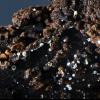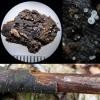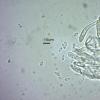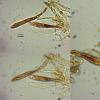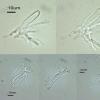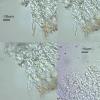
27-11-2025 15:41
Thomas LæssøeSpores brownish, typically 4-celled; 26.8 x 2.4;

27-11-2025 12:01
Thomas Læssøehttps://svampe.databasen.org/observations/10496727

27-11-2025 11:46
Thomas Læssøehttps://svampe.databasen.org/observations/10493918

27-11-2025 11:31
Thomas LæssøeCollectors notes: Immersed ascomata, erumpent thro

23-09-2025 13:31
Thomas Læssøehttps://svampe.databasen.org/observations/10534623

25-11-2025 14:24
Thomas Læssøehttps://svampe.databasen.org/observations/10490522

26-11-2025 18:13
The entire run of Mycotaxon is now available throu

25-11-2025 11:03
Mick PeerdemanHi all,One of my earliest microscopy attempts, so
Found March 24 2015 on a stick in a pile of branches, in a wet flush in acid woodlands, with alder and birch predominant, but wood from many species including oak, sycamore probably present in the pile. Altitude about 1000ft. On a spidery subiculum? Ascocarps up to 300 um (0.3 mm) diameter, sessile. Slightly urn-shaped? The spores were 7-8.5 (10 – but the larger ones possibly germinating) x 3.5 -4, with guttules. Asci with croziers, up to 60 x 10, bluing in Lugol (also reddening of contents). Paraphyses cylindrical, about 2 wide, possibly branching from base (hard to see). Excipular cells rounded, up to 10 wide. The most difficult structures to find were the hairs. From the macro photos these look about 30 um long. They are possibly slightly roughened (no septa seen) and tapering, in contrast to the paraphyses which have rounded ends and are smooth. The hairs weren't clearly visible on a whole ascocarp mount. This fungus was so small that my microscope was at its limit. The images of "hairs" were taken using oil immersion. I used the plurivorous disco key in Ellis and Ellis to get to Cistella or Arachnopeziza.
Steve

I'm surprised that using that key you got those two genera (neither of which resemble what you have there). I just tried the same key and came out at Hyaloscypha . . . .
best wishes
Chris
PS might be worth deleting that duplicate post without the images
As you know I'm not a specialist in such tiny Ascos and as such appreciate any help very much.
At no 9 in the key I chose cobwebby subiculum as there is a suggestion of this in my specimen. I presume the hyphae are other filamentous fungi or not dense enough to be a spidery subiculum. That's how I got to Arachnopeziza.
If no cobwebby subiculum I had to chose hair type at no 10. If the hairs are tapered (not very clear to me in my specimen) then you are quite right - you get Hyaloscypha.
If the hairs are more cylindrical /granular you get to no 12, on chosing paraphyses = filiform you get Cistella.
From this exercise I have l learned:
1) the specimen does not have a spidery subiculum and isn't Arachnopeziza.
2) my recent £10,000 investment in microscopes, cameras and literature are obviously inadequate for this level of identification. You need a far better set of gear for this kind of work.
3) my current level of experience and expertise in Ascos at present is not really appropriate for Asco France.
I shall of course continue to learn, which is what I enjoy doing, and hopefully not make too many daft mistakes,
Thanks again for your valued help and altruism.
Kind regards,
Steve
I happened to open this forum post from earlier today.
Please do not feel that you shouldn't use the Ascofrance forum. Mr Yeates seems to have a way of arousing an inferiority complex in people when he responds on this forum.
I would suggest that if you use Ellis & Ellis along side my book, Ascomycetes in Colour plus the additional species pages, you double the chances of arriving at an identification of the ascomycetes which you find. My colour photographs are an improvement on the E&E black and white line drawings for colourful fungi, and I have covered a reasonable percentage of the ascos in E&E now.
For me, it is 50 – 50 as to whether I start with E&E or AIC, when I am seeking a determination of my fungus samples.
I rarely use the 1980s books B&K vol. 1 and British Ascomycetes, by RWG Dennis. The latter is useful for providing a brief description of a genus and for grouping related genera into families, though.
Also, are you aware that Zotto Baral, who is very expert at the inoperculate discomycetes, has a 'cloud' data store? There is a massive amount of invaluable data, along with photos and drawings available there. Once you have identified a genus (or genus + species) from the literature, accessing this data store will usually confirm, or otherwise, your identification. If you are already confident about the genus of a discomycete, you could then go straight to this data store instead of using the books.
With Best Wishes,
Peter.
Many thanks for keeping us updated with your supplements. I do find your images very useful, as an additional resource to the books which I resort ie Ellis and Ellis and FOS Vol 1. I really appreciate any help at all - we've shown in our survey of Longshaw that its fungi are exceptionally important, and we're working closely with the National Trust to help safeguard some special habitats. Asco France has been really important to us.
Best regards,
Steve
Hi Steve
I endorse Peter's comments in respect to using AscoFrance. It's an amazing forum with very knowledgeable and friendly members who are particularly encouraging to novices like me.
However, I don't agree with his view of Chris Yeates who is very generous with his time in encouraging others with less experience. I personally have benefitted hugely from his help. In this era of 'dumbing down' it's refreshing to have someone speaking plainly - you would need to be very sensitive to feel 'inferior'.
Regards, Chris
I quite agree, Asco France is a shining example what some of us expected the World Wide Web to provide when it first appeared. And I also think that anyone who is attempting to survey a site such as the Longshaw Estate, as comprehensively as possible, can only do so with the generous help of specialists - that's something which we've built into our method of study. Without team work, and respected peer review and validation I don't see why anyone should take our findings seriously. Chris Yeates has been extremely helpful to me over a number of years - I post queries on the forum hoping to be put "on the right path"! I also find Peter Thompson to be very helpful.
Best regards,
Steve
